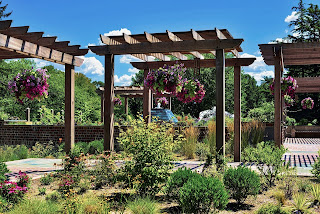Incorporating Edible Plants in your Landscape Design
We can see it now: the sun is setting on a warm summer night over the garden of your dreams. There are freshly picked raspberries on your plate, and the laughing eyes of your youngest seem to light up even more as they enjoy the greatest treat of all: a berry, fresh off the vine, sun-warmed with the sweetness of a late June day.
Do you like the idea of growing your own food, but perhaps don’t know where to start? We do, too, and we also love the trending idea that not all foodscapes have to include a boxy square-foot garden box or an area that reduces the amount of yard your kids have to play in. At Bella Vista Landscape, we love exploring landscaping ideas, and this trend is one we have loved from the moment we heard of it! Homes typically have some kind of garden space around the home, and planting edible plants among your traditional perennials is a great way to maximize space and grow your own vegetables. When you choose to incorporate edible plants along with ornamental ones, you can reduce your food bill while also enjoying an aesthetic garden. Here are six tips to grow the foodscape of your dreams:
Start with a plan.
Unless you’re a seasoned gardener, putting together a foodscape can seem daunting, and you may end up with plants that get too little--or too much--sunlight. Make a plan that accounts for the factors you can predict, such as sunlight, soil quality, and drainage. There are so many options for plants that you can pair together, so it’s a good idea to think about whether certain plants will grow and overshadow others, and whether certain colors or textures might compliment one another. And, since vegetables are typically annual plants, it’s a fairly low-commitment task; if you didn’t like your pairings one year, you can always switch it up the following year.
Choose the right plants.
Do a little bit of research on what plants grow well in your climate and soil conditions. Plants can be fickle, so set yourself up for success by planting vegetation that is more likely to succeed in your area. Plant a variety of annuals and perennials, vegetable plants and ornamental plants, which can keep your garden visually interesting and extend your harvest season as you enjoy different types of vegetables.
Try companion planting.
Different types of plants are known to do well when grown together, which can serve as a big advantage as they can enhance growth and improve soil health when paired together. For example, beans and corn planted together improves soil fertility, which benefits both plants, and tomatoes and basil grown together repels pests and improves the flavor of the tomatoes. There are some wonderful things in nature, and utilizing those blessings can play to your advantage.
Think outside the box.
A trend that’s growing in popularity is to use vertical space. Vertical gardening is especially popular in communities that have limited yard and garden space, and has a charming aesthetic that visually enhances a foodscape. Trellises, arches, and overhead structures can be used to grow climbing plants such as gourds, tomatoes, and beans, and can even prevent bruising and discoloration among crops that would typically lay on the ground.
Practice sustainable gardening.
A healthy and productive foodscape comes from sustainable gardening techniques. Composting scraps is one way to maintain the fertility of your soil, and MULCHING and avoiding chemicals for pest control can also improve sustainability. Building healthy soil, conserving water, and avoiding harsh chemicals will improve the health of your garden.
Harvest regularly.
Fruits and vegetables need to be harvested regularly; this can even help your foodscape produce more produce. While harvesting, keep an eye out for pests and diseases so that you can catch and treat any issues early on. This will help keep your plants healthy and productive throughout the entire growing season.
As spring begins to turn the corner, it’s a wonderful time of year to get a garden in place to enjoy through the summer and autumn months! Whether you need tips and tricks for designing a breathtaking landscape or other landscaping services, our team of experts at Bella Vista Landscape are eager to serve our friends and neighbors in Boise, Meridian, Nampa, ID, and all surrounding areas. Give us a call at (208) 995-3532 or fill out our online contact form for more information today!




Comments
Post a Comment